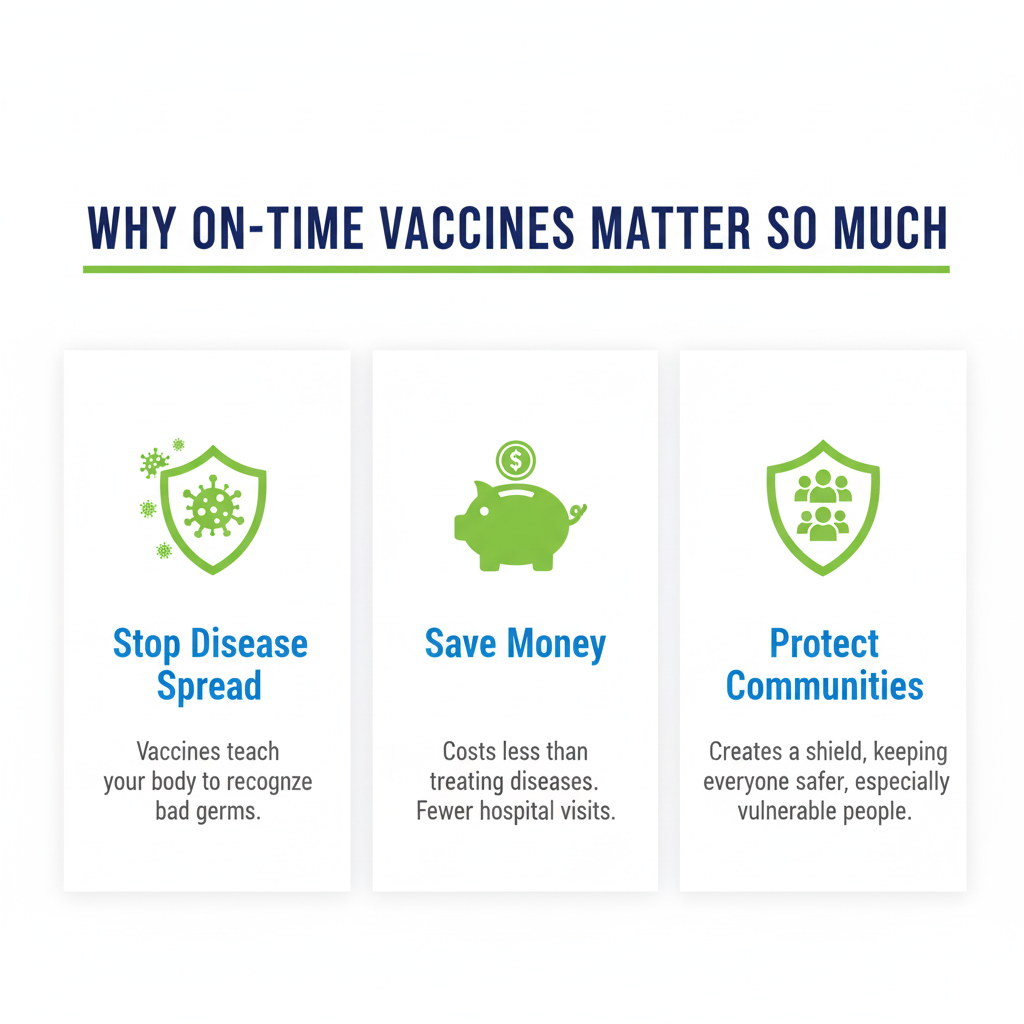Vaccines have helped keep people healthy for many years. They protect us from serious diseases. Getting shots on time is very important. When we follow vaccine schedules, we protect ourselves and others too.
This guide will show you why timing matters with vaccines. You'll learn how they help whole communities stay healthy.
Why On-Time Vaccines Matter So Much
How Vaccines Help Everyone Stay Healthy
Vaccines are one of the best tools doctors have to fight disease. They help our bodies learn to fight germs before we get sick. When lots of people get vaccinated, fewer people get diseases like measles or flu.

Here's what vaccines do for our health:
Stop Disease Spread: Vaccines teach your body to recognize bad germs. This helps you fight them off if they try to make you sick.
Save Money: Getting vaccines costs less than treating diseases. Hospitals see fewer sick people when vaccination rates are high.
Protect Communities: When most people are vaccinated, diseases can't spread easily. This keeps everyone safer.
The Right Time Makes Vaccines Work Better
Getting vaccines at the right time is key. Your body responds best to vaccines at certain ages. Babies and young kids need shots at specific times when their bodies are ready.
Missing vaccine dates can leave you open to getting sick. Some vaccines need several doses to work well. Getting them on time gives you the best protection.
Important Facts About Vaccine Timing:
- Babies get vaccines when they're most at risk for certain diseases
- Some shots need multiple doses spaced weeks or months apart
- Delays can leave gaps where you're not protected
Building Community Protection
When enough people in a area get vaccinated, it creates a shield. This is called community immunity or herd immunity. It protects people who can't get vaccines due to health problems.
Protecting Those Who Can't Get Vaccines:
Some people can't get certain shots because of medical conditions. When others get vaccinated, it helps protect these vulnerable people.
Stopping Outbreaks:
High vaccination rates make it hard for diseases to spread. This prevents big outbreaks that could make many people sick.
Communities need to work together on vaccine schedules. When we all do our part, we protect the most vulnerable people around us.
Main Benefits of Following Vaccine Schedules
Getting Protected at the Right Time
On-time vaccines give you protection when you need it most. This is especially important for babies whose immune systems are still growing.
Baby and Child Protection: Young children face the biggest risks from many diseases. Getting vaccines on schedule protects them during these vulnerable times.

Keeping Immunity Strong:
Some vaccines need booster shots later. These help keep your protection strong as you get older.
Stopping Disease Outbreaks Before They Start
Following vaccine schedules helps prevent outbreaks. When vaccination rates drop, old diseases can come back.
Real examples show what happens when people skip vaccines. Measles outbreaks have happened in areas where fewer children got their shots. Getting vaccines on time stops these problems before they start.
Long-Term Health Benefits for Kids
Children who get vaccines on time are healthier throughout their lives. They avoid serious complications that some diseases can cause.
Better Development: Kids who don't get sick from preventable diseases can grow and learn better. Their bodies and brains develop normally.
Avoiding Serious Problems: Some diseases can cause blindness, hearing loss, or brain damage. Vaccines prevent these scary complications.
Diseases You Can Prevent with Vaccines
How Vaccines Teach Your Body to Fight Disease
Vaccines work by showing your immune system what bad germs look like. They use weakened or dead germs that can't make you sick. Your body learns to recognize these germs and makes antibodies to fight them.

How It Works: When you get a vaccine, your body practices fighting the disease. If you meet the real germ later, your body already knows how to beat it.
Many Diseases Covered:
Regular vaccines protect against measles, mumps, rubella, whooping cough, flu, and many other serious diseases.
Learning from Past Outbreaks
History shows us what happens when vaccination rates drop. Several diseases have made comebacks in recent years.
Measles Returns: Some communities that stopped vaccinating saw measles outbreaks. Children got very sick with a disease that was almost gone.
Whooping Cough Problems: Areas with low vaccination rates have seen more whooping cough cases. This disease is very dangerous for babies.
How Community Immunity Works
Community immunity happens when enough people are protected. The exact number needed varies by disease. Most diseases need about 85-95% of people to be immune.
Blocking Disease Spread:
When most people are immune, diseases can't find new people to infect. This stops outbreaks from happening.
Protecting Everyone:
People who can't get vaccines still stay safe when everyone else is protected.
%20(1).png)
The Science Behind Vaccine Timing
Why Timing Is So Important
Scientists study diseases and immune systems to figure out the best times for vaccines. Each shot is scheduled when it will work best and be safest.
Best Immune Response
Vaccines work best when given at the right age. Too early and the immune system might not be ready. Too late and you might already be exposed to the disease.
Growth Stages
For children, vaccines are timed with important growth periods. This gives the best protection when kids need it most.
Research Supports Vaccine Schedules
Years of studies back up current vaccine schedules. Scientists track how well vaccines work and adjust timing as needed.
Proven Effectiveness: Studies show vaccines work best when given on schedule. Changes to timing can make them less effective.
Safety Data: Research proves that recommended schedules are safe for children and adults.
Problems with Late Vaccines
Delaying vaccines creates risks for individuals and communities.
Higher Infection Risk: People without vaccines are more likely to get sick. Children face the biggest dangers from delayed shots.
Community Risk: When many people delay vaccines, the whole community becomes vulnerable to outbreaks.
Vaccine Schedules for Children: Parent Guide
Important Vaccines by Age
Parents need to know which vaccines their children need and when. Here's a simple breakdown:

Babies (Birth to 2 Years): Hepatitis B, DTaP, Hib, Polio, Pneumococcal, and Rotavirus vaccines are crucial during this time.
Young Children (3 to 6 Years): MMR, Chickenpox, and booster shots for DTaP and Polio.
Teens (7 to 18 Years): HPV, Tdap booster, Meningococcal, and yearly flu shots.
Keeping Track of Vaccine Schedules
Staying organized helps ensure on-time vaccines:
Use Reminders: Set up phone alerts or calendar reminders for upcoming shots.
Talk to Your Doctor: Regular check-ups help you stay on track. Your pediatrician can answer questions about specific vaccines.
Addressing Parent Worries
Many parents have concerns about vaccine timing and safety. Getting good information helps:
Ask Your Doctor: Healthcare providers can explain vaccine benefits and address safety concerns.
Use Trusted Sources: Get information from reliable sources like the CDC or your child's doctor.
Strategies for Staying on Schedule
Tools to Help You Remember
Several resources can help families keep up with vaccine schedules:
Reminder Systems: Many doctors' offices send reminders by phone, email, or text.
Health Apps: Phone apps can track your child's vaccines and remind you when shots are due.
.png)
Working with Your Healthcare Team
Building good relationships with healthcare providers helps maintain vaccine schedules:
Regular Visits: Routine appointments give chances to get vaccines on time and discuss any concerns.
Personalized Plans: Some children need special vaccine schedules due to health conditions. Your doctor can create a plan that works for your child.
Community Support
Communities can work together to promote timely vaccination:
Education Programs: Schools and health departments can teach families about vaccine benefits.
Parent Groups: Talking with other parents can provide support and share experiences about vaccination.
Clearing Up Vaccine Myths
Setting the Record Straight on Safety
Some myths about vaccines can prevent people from getting shots on time. Here are the facts:

Vaccines Are Safe: All vaccines go through careful testing before approval. Serious side effects are very rare.
Minor Side Effects: Some people get sore arms or low fevers after shots. These are normal signs that the vaccine is working.
Understanding How the Immune System Works
Some parents worry about giving children multiple vaccines:
Strong Immune Systems: Children's bodies can handle many vaccines at once. Their immune systems are designed to fight multiple germs.
Right for Each Age: Vaccine schedules match how children's immune systems develop.
Multiple Vaccines Are Safe
Getting several vaccines during one visit is safe and helpful:
Complete Protection: Multiple vaccines protect against several diseases at once during vulnerable periods.
Research Confirms Safety: Studies consistently show that getting multiple vaccines together is safe.
Looking Ahead: Future of Vaccination
New Ways to Give Vaccines
Scientists are working on easier ways to deliver vaccines:
Patch Technology: New patches with tiny needles could make vaccines easier to give.
Oral Vaccines: More vaccines that you can swallow instead of getting shots.
Global Efforts
Countries around the world are working together to improve vaccination:
Working Together: International groups help share vaccines and knowledge.
Reaching Everyone: Mobile clinics and digital health programs help people in remote areas get vaccines.
Policy Changes That Help
Government decisions affect how well vaccination programs work:
School Requirements: Laws requiring vaccines for school help keep vaccination rates high.
Insurance Coverage: Making vaccines affordable helps more families get them on time.
Conclusion
Timely vaccines are one of the best ways to stay healthy. Following vaccine schedules protects you and helps your whole community. When we get vaccines on time, we protect babies, elderly people, and others who might not be able to get certain shots.
For parents, staying on top of vaccine schedules is a key part of keeping children healthy. It means making sure kids get protection when they need it most.
The science behind vaccine timing is solid. Researchers have spent decades figuring out the best times for each vaccine. These schedules give the most protection with the best safety.
Looking forward, new technologies and global cooperation will make vaccines even better. By staying informed and following recommended schedules, we can all help keep our communities healthy.
Frequently Asked Questions
Why are on-time vaccines so important?
On-time vaccines protect people when they're most vulnerable to diseases. Following schedules helps keep community immunity high, which protects everyone - especially people who can't get certain vaccines due to health problems.
What happens if I delay my child's vaccines?
Delaying vaccines leaves children unprotected during risky periods. This increases chances of getting sick from preventable diseases. For communities, low vaccination rates can lead to outbreaks of diseases that were previously controlled.
How can I make sure my child gets vaccines on time?
Keep regular appointments with your pediatrician and use reminder systems. Many healthcare providers offer reminder services. You can also use phone apps designed to track vaccination schedules.
What should I do if my child misses a scheduled vaccine?
Contact your healthcare provider right away to reschedule. Most vaccines can still be given within a flexible timeframe. Your doctor can help create a catch-up schedule to get your child protected as soon as possible.
How do vaccines help community immunity?
Vaccines reduce the number of people who can get and spread diseases. When enough people are vaccinated, it creates a protective barrier that stops diseases from spreading easily. This protects people who can't get vaccines due to medical conditions.
.png)



.png)
.png)
.png)
.png)
.png)
.png)
.png)

.png)
.png)
.png)

.png)
.png)
.png)
.png)
.png)
.png)

.png)
.png)

.png)
.png)
.png)

.png)

.png)


.png)







